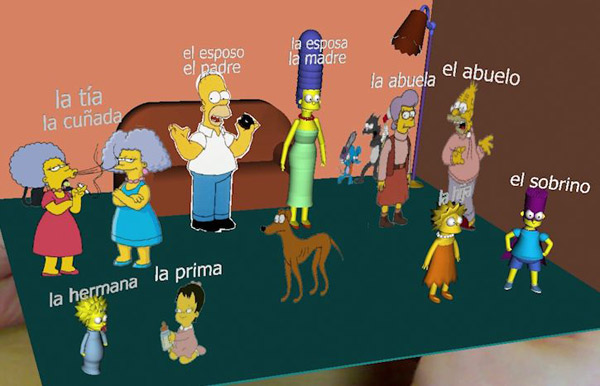This is the third experiment we conducted in Spanish 101 class with the aid of Augmented Reality models (experiment 1, experiment 2). Dr. Socorro Zaragoza wanted to determine what effects does AR have on student language speaking, writing, reading, listening skills as well as the language comprehension.
Each experiment corresponded to the textbook lesson for SPA 101 and the goal of each experiment was to determine if Augmented Reality influenced student learning. Topic of our third lesson/experiment was family and family members (miembros de la familia). Dr. Zaragoza suggested that we use “The Simpsons” as a model to portray family relations. We couldn’t replicate the scene from the textbook due to the space and design limitations, but we managed to squeeze in the following family relations and members: el/la abuelo/a: grandfather/grandmother, el/la cuñado/a: brother-in-law/sister-in-law, el/la esposo/a: husband/wife, el/la hermano/a: brother/sister, el/la hijo/a: son/daughter, la madre: mother, el/la nieto/a: grandson/granddaughter, el/la primo/a: cousin, el/la sobrino/a: nephew/niece and el/la tío/a uncle/au nt (Figure 1).
We designed the Simpsons model in Google SketchUp. Google SketchUp is relatively simple to use and Google 3D marketplace offers myriad of free 3D models that can be imported into the scene you are designing. After quick search, we found several 3D models of Marge, Lisa, Bart and Maggie and imported them into the Sketchup. We also found several models of Homer Simpson, but they did not look natural in 3D. Instead, we decided to make 2D models of Homer and the remaining family members that we could not recreate in 3D (grandma, grandpa Abe, 2 aunts, Itchy and Scratchy and Santa’s Little Helper). Once we had our images of family members, we removed the background from the photos and exported them in PNG file format from Photoshop. These files are than imported as textures in Sketchup and applied to 3D primitives (cube). With some adjustments, we rather quickly recreated the entire living room (Figure 1).
In addition to the models, we decided to integrate vocabulary into the augmented reality scene. This was suggested by several students during the preliminary interviews and we believe that it would eliminate split attention effect (Cognitive Load Theory). Split attention effect was created during the exercises where students would look at the augmented reality model and then look at the textbook to to learn the vocabulary associated with that model. This process creates memory overload since the learners have to hold the scene image in their working memory while trying to learn the vocabulary. Integrating the vocabulary and the models eased the burden on their working memory as suggested by Kalyuga, Chandler & Sweller (1999).
Once we had our model of a classroom in a 3DS file, the course instructor decided that this will be a collaborative exercise. Students worked in groups and were able to freely manipulate the AR markers with their hands. We visited the experimental classroom and loaded each computer with a BuildAR viewer, premade scene (loaded with marker and resized Simpsons model) and a Logitech 9000 Web cams (6 in total). The video below depict the the entire process and shows students interacting with the augmented reality model.
Download source files here (SPA 101 3D classroom files, AR marker and marker PDF file). We posted a brief instructional video on how to open up a scene on YouTube: http://www.youtube.com/watch?v=f3C97PPTinE
References
Kalyuga, S., Chandler, P., & Sweller, J. (1999). Managing split-attention and redundancy in multimedia instruction. Applied Cognitive Psychology, 13(4), 351-371. Retrieved from EBSCOhost.

